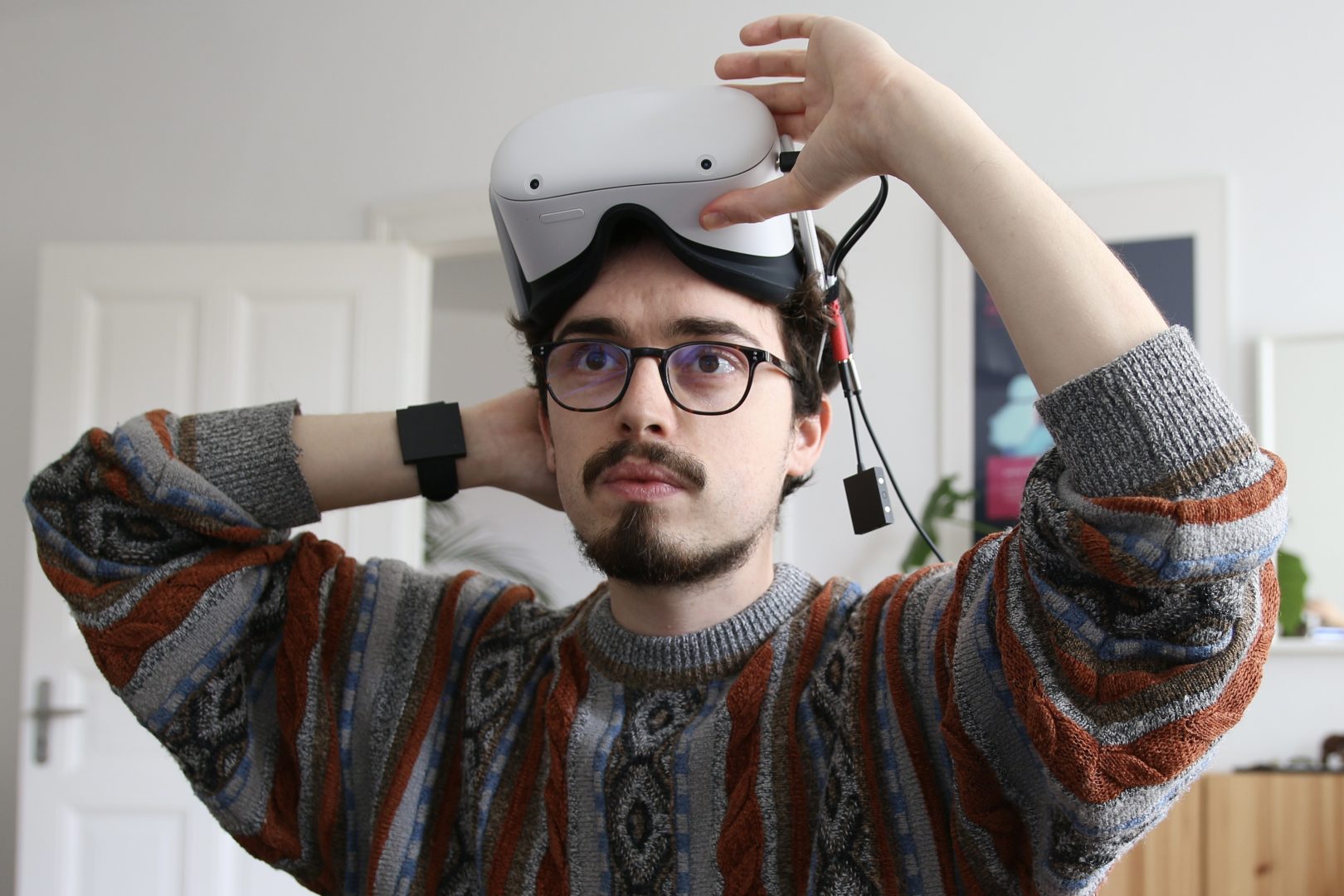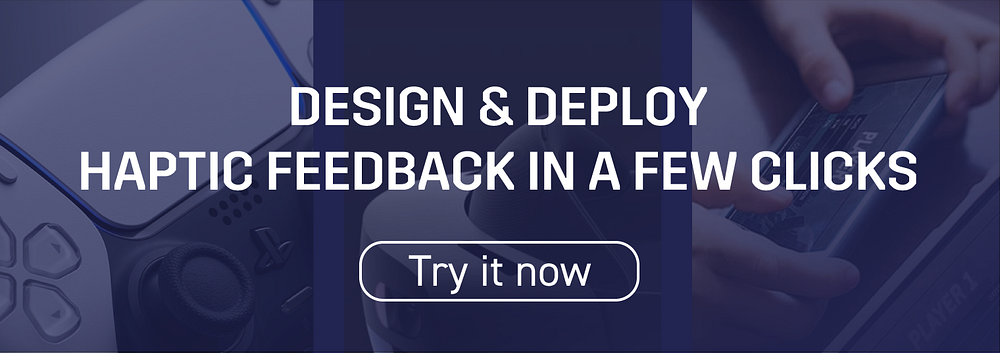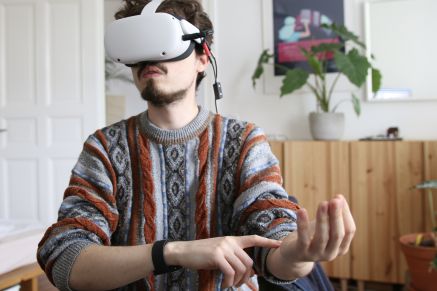The Haptics club is an Open community about #Haptics. Founded by members of Unity, Interhaptics, Senseglove, and Nanoport. An event every other week with speakers from various industries and academia.
Do you want to listen to the full podcast?

Who is Simon Frübis ?
Simon Frübis is an user interface (UI) and extended reality (XR) prototyper, researcher, and interaction design consultant. He has over 7 years of experience in design, digital marketing and basics in front-end development, and designed websites and marketing products for companies like SAP as head of design. For his master thesis, he investigated multisensory feedback for AR and VR. By creating virtual wearables and including haptics for extended reality and audio, Simon evaluates the effects of multisensory feedback on the user experience (UX). Earlier this year he resigned from his co-founder position at innofabrik to place his full time focus on his passion for XR.
His latest project, a prototype wristband for hands-free, haptic enabled user interaction in XR, has rocketed him into the public spotlight.

Why Haptics in the XR?
Simon was quick to point out that haptic feedback design make it a lot more efficient for us to engage with computers because it provides a more precise, secure confirmation of each interaction. Considering the sheer number of devices and programs we interact with every single day, these seconds could easily build into minutes and hours of our lives saved by efficiency. At his first VR experience, Simon felt like his brain didn’t understand when he pressed the button. With his XR project and the haptic feedback design added, he reached the treshold of that interaction feeling.
Haptics plays a fundamental role in giving XR a sense of touch. This is valuable whether it’s in health care, usability in VR, productivity, etc. It also opens new possibilities for remote work, showcasing ideas and being close together when you’re not close.
What about haptics design from a UX design perspective?
Today, there’s huge potential in designing applications for your hands because it has never been possible to interact so closely with a machine. With VR and AR, human machine interaction has the potential to be more natural than ever, and hand tracking adds a new dimension of interaction design.
In terms of using haptic design as part of the user interaction journey, Simon shared some real-life examples:
- How long should the vibration be to not create an alert effect?
- What’s enough feedback so you know when you pressed a button?
- How loud should the haptic feedback be?
- What should the haptics feel like in combination with audio?
- How should scrolling, drag and drop, and snapping feel like?
“This is a call to XR designers to find new ways to make experiences more emotional, fun, explorative and human friendly, and to get out of this 2D’ish world and grab onto the new possibilities of spatial computing,” Simon said.

Anyone can Build the Future
Early in the process, Simon felt intimidated by the sheer amount of learning that was ahead of him for the wristband project. “I told myself as a designer, I’m not able to do all of this. Like learning coding and haptics.” His advice is to have a vision that you want to solve and focus on something you find cool and interesting. That way, you’ll stay inspired when you’re inevitably stuck in endless troubleshooting.
Simon also shared one of his favorite quotes by Joshua Blake, Orbbec co-founder and ‘NUI Nerd. “Don’t let anyone else ever tell you that you can’t work on a technology you find cool. The only person holding you back is yourself. Make some time, take some risks. Find a way to do what you love!”
In terms of hands-on implementation, Simon stated the importance of leveraging existing resources, as a way to get up to speed quickly. Specifically mentioning Microsoft’s Mixed Reality Toolkit (MRTK) and the vast resources available for Unity.
To learn more about his project, check out this video and stay in tune with his latest updates by following him on LinkedIn.
The future of haptics
For the time being haptics is not a topic because it is a side thing that is nice to have, but when you don’t have you feel like something is muted or missing. He is looking forward to new applications like the sharing of haptic on iphone and android to all your team and collaborate with that like a photoshop file. People can easily try it out when needed. The wristband is also a nice place to add haptics because I think smartdevices will become more and more powerful and will play a big rôle in the field of XR.
As a user interface (UI) prototyper, Simon is sure that haptics will be part of XR design agencies. In the coming years there will be a big shift for designers, they will have to switch to XR and start creating XR advertising, XR game expériences and use haptic on iphone and android. Multisensory combination is a field that needs to be explored and will play a big rôle for the futur of haptics.
Simon is excited to see what Facebook and Apple, already using haptic on iphone, will provide in these fields and how they implement haptics in their universe to create more immersive expériences.

What about Simon’s future ?
Simon wants to learn more and more of the XR fields, for that he will be searching for a company that is already. He is also thinking about creating medium’s article to explain his master thesis work and share all his processes and haptic design. With that it could be a nice way to share a way to create new haptic feedback design. For his basslet project, he would like to improve it by having all the connectics inside of the armband. In his opinion, a second version of the basslet focused on the XR industry could find even more success then for the music industry.
Who is the haptics club?
The Haptics Club was founded by Manuel Sainsily from Unity, Ashley Huffman from Nanoport, Gijs den Butter and Irina Tripapina from Senseglove, and Eric Vezzoli and Sarah Alkibsy from Interhaptics.
Follow the Haptics Club on Twitter and LinkedIn to stay updated with the next events.
Who is interhaptics?
Interhaptics is a software company specialized in haptics. Interhaptics provides hand interactions and haptic feedback development and deployment tools for virtual reality (VR), mixed reality (MR), mobile haptic for iphone and android, augmented reality (AR), and console applications. Interhaptics’ mission is to enable the growth of a scalable haptics ecosystem. Interhaptics strives to deliver top-notch development tools for the VR/MR/AR, mobile, and console developer community, and the interoperability of haptics-enabled content across any haptics-enabled platform.








